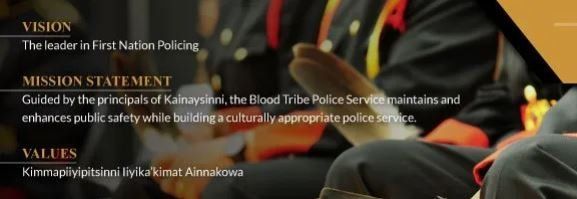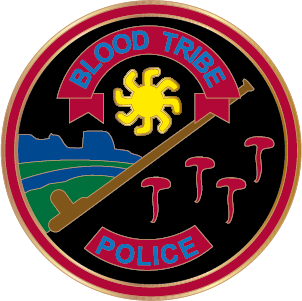Get in touch
Emergency CALL 911
(403) 737-8800 Administration
BLOOD TRIBE POLICE SERVICE PO Box 300
Standoff, Alberta T0L 1Y0 Canada
(403) 737-3800
Complaint Line
(403) 737-8800 Administration
(403) 737-2867
Fax
(403) 737-8814
Victim Services
(800)-222-TIPS (8477) Crime Stoppers
(403) 737-8808
Tips
BLOOD TRIBE POLICE SERVICE PO Box 300
Standoff, Alberta T0L 1Y0 Canada
NEWS
|
UNITS | CAREERS
|
VICTIM SERVICES UNIT
About Us

Policing has always been an important component to the way of life for the Blood Tribe. Traditionally the Tribe had a fully developed legal system and its own enforcement agency in the form of a society called Iikunuhkahtsi to apply the laws. However, as the European systems began to overlay the ways of the Tribe, policing and other areas of social services adapted and have continued to become an integral part of the Blood Tribe community. To suit the particular context and needs of its people, the Blood Tribe adopted the Tribal Scout system which later evolved into the Blood Tribe Police Service.
The Blood Tribe (BIR# 148 & 148A) is the largest Indigenous community in Canada. Covering well over 180 000 hectares of land in Southern Alberta, it is the proud home to over 10 000 members. Basing our operations in Standoff, Alberta, the Blood Tribe Police Service is a fully autonomous police agency with jurisdiction that extends from the outskirts of the city of Lethbridge to the bordering towns of Cardston, Hill Spring, Glenwood, Fort Macleod and Waterton Lakes National Park. Twenty-four hours, seven days a week coverage is provided by thirty three fully appointed police officers with the support of over twenty six full time civilian staff members. Provincially and federally recognized training, a large fleet of police vehicles, state of the art blood alcohol testing equipment, and full access to services such as the Canadian Police Information Centre (CPIC), and the Police Reporting and Occurrence System (PROS) are just some of the resources utilized by the Blood Tribe Police Service. The Blood Tribe Police Service in its present form is a continuation of the Blood Tribe in partnership with the Federal and Provincial Governments' efforts in providing quality policing services to the community.
Our Crest
The Blood Tribe Police Service crest is truly unique as it represents the heritage of our organization and its role within the community of the Blood Tribe.
The sun, river and grass are symbolic of Treaty 7. The Treaty states that: "…as long as the sun shall shine, as long as the rivers flow and as long as the grass shall grow…" the rights and liberties of the Blood Tribe will be honoured.
The peace pipe is also representative of the treaty as well as a symbol of the Blood Tribe Police Service's role as Peace Keepers in the traditional native culture.
The mountain in the distance represents Chief Mountain, an actual landmark so named because it appears as though a Chief in full traditional headdress is resting under the sun.
The "T" shaped symbols are the marks that used to be written in the sand or dirt to represent the presence of the Tribal Scouts, the original Peace Keepers within the Tribe. The marks were pointed upwards to represent the path that the Scouts bravely took would lead the Tribe well into the future.
Our Story
Policing has always been an important component to the way of life for the Blood Reserve and its people.
Traditionally the Tribe had a fully developed legal system and its own enforcement agency in the form of a society called Iikunuhkahtsi to apply the laws. However, as the European systems began to overlay the ways of the tribe, policing and other areas of social services adapted and have continued to become an integral part of the Blood Tribe community.
To suit the particular context and needs of its people, the Blood Tribe adopted the Tribal Scout system which later evolved into the Blood Tribe Police Service.
Our Service
The Blood Tribe (BIR# 148 & 148A) is the largest First Nations reservation in Canada. Covering well over 180 000 hectares of land in Southern Alberta, it is the proud home to over 12 000 registered members.
Basing its operations out of offices in Standoff, Alberta, the Blood Tribe Police Service is a fully autonomous police agency with jurisdiction that extends from the outskirts of the city of Lethbridge to the bordering towns of Cardston, Hill Spring, Glenwood, Fort Macleod and Waterton Lakes National Park.
Twenty-four hours, seven days a week coverage is provided by fully appointed police officers with the support of over full time civilian staff members. Provincially and federally recognized training, a large fleet of police vehicles, state of the art blood alcohol testing equipment, and full access to services such as the Canadian Police Information Centre (CPIC), and the Police Reporting and Occurrence System (PROS) are just some of the resources utilized by the Blood Tribe Police Service.
The Blood Tribe Police Service in its present form is a continuation of the Blood Reserve in partnership with the Federal and Provincial Governments' efforts in providing quality policing services to the community.
The Blood Tribe (BIR# 148 & 148A) is the largest Indigenous community in Canada. Covering well over 180 000 hectares of land in Southern Alberta, it is the proud home to over 10 000 members. Basing our operations in Standoff, Alberta, the Blood Tribe Police Service is a fully autonomous police agency with jurisdiction that extends from the outskirts of the city of Lethbridge to the bordering towns of Cardston, Hill Spring, Glenwood, Fort Macleod and Waterton Lakes National Park. Twenty-four hours, seven days a week coverage is provided by thirty three fully appointed police officers with the support of over twenty six full time civilian staff members. Provincially and federally recognized training, a large fleet of police vehicles, state of the art blood alcohol testing equipment, and full access to services such as the Canadian Police Information Centre (CPIC), and the Police Reporting and Occurrence System (PROS) are just some of the resources utilized by the Blood Tribe Police Service. The Blood Tribe Police Service in its present form is a continuation of the Blood Tribe in partnership with the Federal and Provincial Governments' efforts in providing quality policing services to the community.
Our Crest
The Blood Tribe Police Service crest is truly unique as it represents the heritage of our organization and its role within the community of the Blood Tribe.
The sun, river and grass are symbolic of Treaty 7. The Treaty states that: "…as long as the sun shall shine, as long as the rivers flow and as long as the grass shall grow…" the rights and liberties of the Blood Tribe will be honoured.
The peace pipe is also representative of the treaty as well as a symbol of the Blood Tribe Police Service's role as Peace Keepers in the traditional native culture.
The mountain in the distance represents Chief Mountain, an actual landmark so named because it appears as though a Chief in full traditional headdress is resting under the sun.
The "T" shaped symbols are the marks that used to be written in the sand or dirt to represent the presence of the Tribal Scouts, the original Peace Keepers within the Tribe. The marks were pointed upwards to represent the path that the Scouts bravely took would lead the Tribe well into the future.
Our Story
Policing has always been an important component to the way of life for the Blood Reserve and its people.
Traditionally the Tribe had a fully developed legal system and its own enforcement agency in the form of a society called Iikunuhkahtsi to apply the laws. However, as the European systems began to overlay the ways of the tribe, policing and other areas of social services adapted and have continued to become an integral part of the Blood Tribe community.
To suit the particular context and needs of its people, the Blood Tribe adopted the Tribal Scout system which later evolved into the Blood Tribe Police Service.
Our Service
The Blood Tribe (BIR# 148 & 148A) is the largest First Nations reservation in Canada. Covering well over 180 000 hectares of land in Southern Alberta, it is the proud home to over 12 000 registered members.
Basing its operations out of offices in Standoff, Alberta, the Blood Tribe Police Service is a fully autonomous police agency with jurisdiction that extends from the outskirts of the city of Lethbridge to the bordering towns of Cardston, Hill Spring, Glenwood, Fort Macleod and Waterton Lakes National Park.
Twenty-four hours, seven days a week coverage is provided by fully appointed police officers with the support of over full time civilian staff members. Provincially and federally recognized training, a large fleet of police vehicles, state of the art blood alcohol testing equipment, and full access to services such as the Canadian Police Information Centre (CPIC), and the Police Reporting and Occurrence System (PROS) are just some of the resources utilized by the Blood Tribe Police Service.
The Blood Tribe Police Service in its present form is a continuation of the Blood Reserve in partnership with the Federal and Provincial Governments' efforts in providing quality policing services to the community.
About Blood Tribe Police Service
The Blood Tribe Police Service in its present form is a continuation of the Blood Reserve in partnership with the Federal and Provincial Governments' efforts in providing quality policing services to the community.
ABOUT US
UNITS
CAREERS
RESOURCES
MAILING ADDRESS
BLOOD TRIBE POLICE SERVICE
P. O. Box 300
Standoff, Alberta T0L 1Y0
Canada
HOURS:
We are operational 24 hours/ 7 days a week.
Front desk hours Monday - Friday 8:30 am-4:30 pm. Closed for lunch 12:00 - 1:00 pm.
FOLLOW US
EMERGENCY CALL 911
(403) 737-3800 Complaint Line
(403) 737-8800 Administration
(403) 737-2867 Fax
(403) 737-8814 Victim Services
(800)-222-TIPS (8477) Crime Stoppers
© 2025
All Rights Reserved | Blood Tribe Police Service
